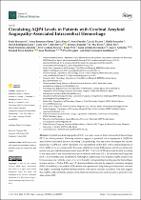| dc.contributor | Vall d'Hebron Barcelona Hospital Campus |
| dc.contributor.author | Marazuela Fuentes, Paula |
| dc.contributor.author | Bonaterra Pastra, Anna |
| dc.contributor.author | Faura Llorens, Julia |
| dc.contributor.author | Penalba Morenilla, Anna |
| dc.contributor.author | Pizarro Gonzálvez, Jesús |
| dc.contributor.author | Pancorbo Rosal, Olalla |
| dc.contributor.author | Rodriguez Luna, David |
| dc.contributor.author | Vert Soler, Carla |
| dc.contributor.author | Rovira Cañellas, Alex |
| dc.contributor.author | Pujadas Navinés, Francesc |
| dc.contributor.author | Montaner Villalonga, Joan |
| dc.contributor.author | Delgado Martínez, Maria Pilar |
| dc.contributor.author | Hernandez Guillamon, Maria Mar |
| dc.date.accessioned | 2021-11-19T08:55:36Z |
| dc.date.available | 2021-11-19T08:55:36Z |
| dc.date.issued | 2021-03-02 |
| dc.identifier.citation | Marazuela P, Bonaterra-Pastra A, Faura J, Penalba A, Pizarro J, Pancorbo O, et al. Circulating AQP4 Levels in Patients with Cerebral Amyloid Angiopathy-Associated Intracerebral Hemorrhage. J Clin Med. 2021 Mar 2;10(5):989. |
| dc.identifier.issn | 2077-0383 |
| dc.identifier.uri | https://hdl.handle.net/11351/6568 |
| dc.description | Aquaporin 4; Cerebral amyloid angiopathy; Magnetic resonance imaging markers |
| dc.description.abstract | Cerebral amyloid angiopathy (CAA) is a major cause of lobar intracerebral hemorrhage (ICH) in elderly patients. Growing evidence suggests a potential role of aquaporin 4 (AQP4) in amyloid-beta-associated diseases, including CAA pathology. Our aim was to investigate the circulating levels of AQP4 in a cohort of patients who had suffered a lobar ICH with a clinical diagnosis of CAA. AQP4 levels were analyzed in the serum of 60 CAA-related ICH patients and 19 non-stroke subjects by enzyme-linked immunosorbent assay (ELISA). The CAA–ICH cohort was divided according to the time point of the functional outcome evaluation: mid-term (12 ± 18.6 months) and long-term (38.5 ± 32.9 months) after the last ICH. Although no differences were found in AQP4 serum levels between cases and controls, lower levels were found in CAA patients presenting specific hemorrhagic features such as ≥2 lobar ICHs and ≥5 lobar microbleeds detected by magnetic resonance imaging (MRI). In addition, CAA-related ICH patients who presented a long-term good functional outcome had higher circulating AQP4 levels than subjects with a poor outcome or controls. Our data suggest that AQP4 could potentially predict a long-term functional outcome and may play a protective role after a lobar ICH. |
| dc.language.iso | eng |
| dc.publisher | MDPI |
| dc.relation.ispartofseries | Journal of Clinical Medicine;10(5) |
| dc.rights | Attribution 4.0 International |
| dc.rights.uri | http://creativecommons.org/licenses/by/4.0/ |
| dc.source | Scientia |
| dc.subject | Cervell - Malalties |
| dc.subject | Cervell - Imatgeria |
| dc.subject | Hemorràgia cerebral |
| dc.subject.mesh | Cerebral Amyloid Angiopathy |
| dc.subject.mesh | /diagnostic imaging |
| dc.subject.mesh | Intracranial Hemorrhage, Hypertensive |
| dc.title | Circulating AQP4 Levels in Patients with Cerebral Amyloid Angiopathy-Associated Intracerebral Hemorrhage |
| dc.type | info:eu-repo/semantics/article |
| dc.identifier.doi | 10.3390/jcm10050989 |
| dc.subject.decs | angiopatía amiloide cerebral |
| dc.subject.decs | /diagnóstico por imagen |
| dc.subject.decs | hemorragia intracraneal hipertensiva |
| dc.relation.publishversion | https://doi.org/10.3390/jcm10050989 |
| dc.type.version | info:eu-repo/semantics/publishedVersion |
| dc.audience | Professionals |
| dc.contributor.organismes | Institut Català de la Salut |
| dc.contributor.authoraffiliation | Marazuela P, Bonaterra-Pastra A, Faura J, Penalba A, Pizarro J, Delgado P, Hernández-Guillamon M] Laboratori d'Investigació Neurovascular, Vall d’Hebron Institut de Recerca (VHIR), Barcelona, Spain. Universitat Autònoma de Barcelona, Bellaterra, Spain. [Pancorbo O, Rodríguez-Luna D] Unitat d’Ictus, Servei de Neurologia, Vall d’Hebron Hospital Universitari, Barcelona, Spain. [Vert C, Rovira A] Grup de Recerca en Neuroradiologia, Servei de Radiologia, Vall d’Hebron Hospital Universitari, Barcelona, Spain. [Pujadas F] Unitat de Demències, Servei de Neurologia, Vall d’Hebron Hospital, Barcelona, Spain. [Montaner J] Laboratori d'Investigació Neurovascular, Vall d’Hebron Institut de Recerca (VHIR), Barcelona, Spain. Universitat Autònoma de Barcelona, Bellaterra, Spain. Department of Neurology, Virgen Macarena University Hospital, Sevilla, Spain. Stroke Research Program, Institute of Biomedicine of Sevilla, IBiS, Virgen del Rocío University Hospital, University of Sevilla, Sevilla, Spain |
| dc.identifier.pmid | 33801197 |
| dc.identifier.wos | 000628314200001 |
| dc.relation.projectid | info:eu-repo/grantAgreement/ES/PE2013-2016/PI17%2F00275 |
| dc.relation.projectid | info:eu-repo/grantAgreement/ES/PE2017-2020/PI20%2F00465 |
| dc.relation.projectid | info:eu-repo/grantAgreement/ES/PE2013-2016/RD16%2F0019%2F0021 |
| dc.relation.projectid | info:eu-repo/grantAgreement/ES/PE2013-2016/CPII17%2F00010 |
| dc.rights.accessrights | info:eu-repo/semantics/openAccess |

